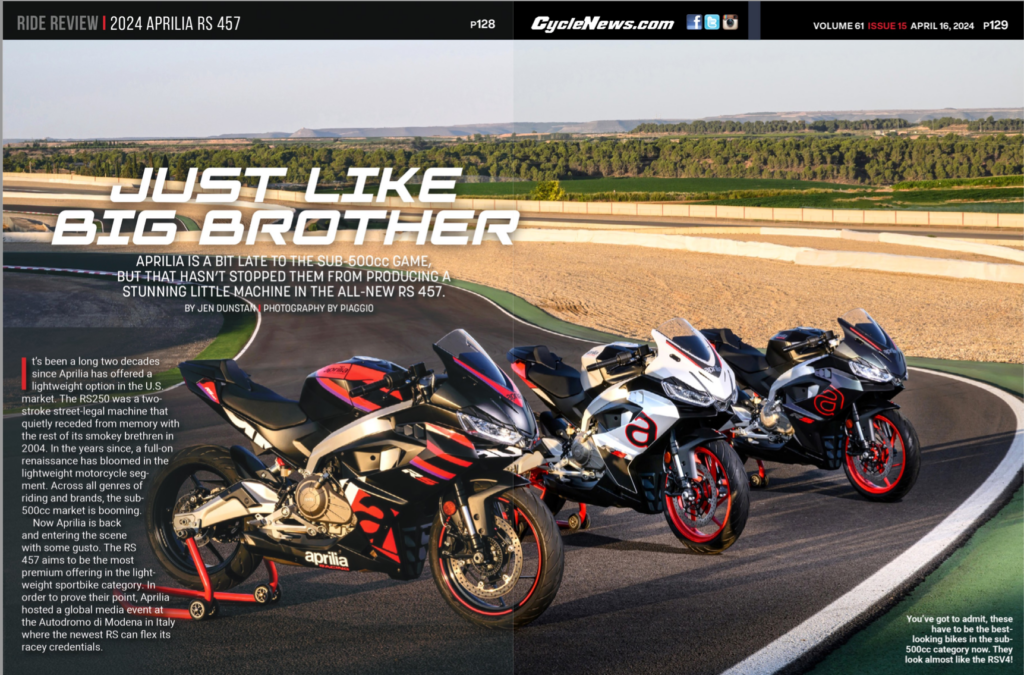| April 24, 2024
It’s been a long two decades since Aprilia has offered a lightweight option in the U.S. market. The RS250 was a two-stroke street-legal machine that quietly receded from memory with the rest of its smokey brethren in 2004. In the years since, a full-on renaissance has bloomed in the lightweight motorcycle segment. Across all genres of riding and brands, the sub-500cc market is booming.
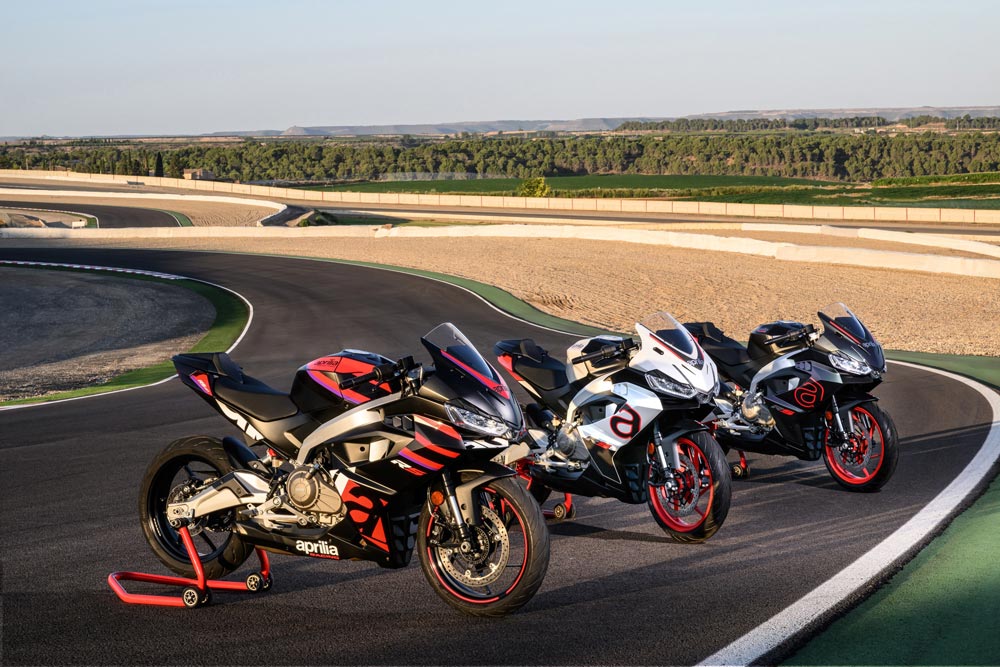 You’ve got to admit, these have to be the best-looking bikes in the sub-500cc category now. They look almost like the RSV4!
You’ve got to admit, these have to be the best-looking bikes in the sub-500cc category now. They look almost like the RSV4!
By Jen Dunstan | Photography by Piaggio
Now Aprilia is back and entering the scene with some gusto. The RS 457 aims to be the most premium offering in the lightweight sportbike category. In order to prove their point, Aprilia hosted a global media event at the Autodromo di Modena in Italy where the newest RS can flex its racey credentials.
Engine | 2024 Aprilia RS 457 Review
Aprilia’s product manager, Allesandro Galli, insisted the new 457cc parallel twin was not simply a “shrunk down 660,” saying they started with a blank piece of paper and a mission to build a class-leading powerplant for the latest sibling to the RS family.
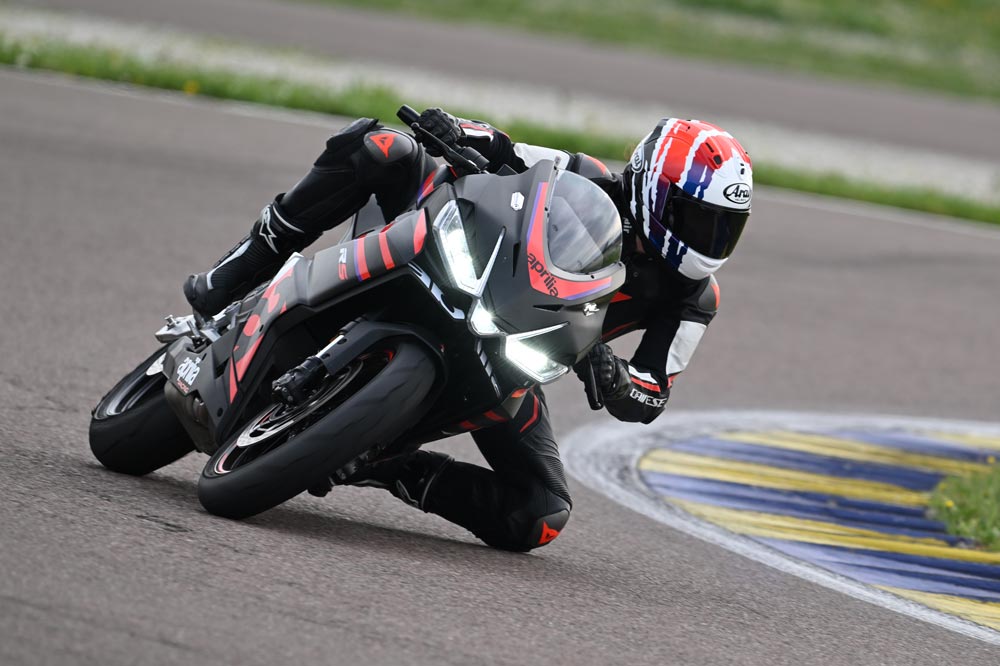 Nimble and agile have been Aprilia chassis characteristics for a generation. The RS 457 continues this approach.
Nimble and agile have been Aprilia chassis characteristics for a generation. The RS 457 continues this approach.
The result is a liquid-cooled forward-facing parallel twin-cylinder with double camshafts and four valves per cylinder, which reaches a maximum power of 47.6 horsepower at 9400 rpm. When it comes to torque, the RS 457 puts out 32 ft-lb at 6700 rpm. Aprilia claims the RS 457 makes 82 percent of that torque by the 3000-rpm range.
Aprilia has taken lessons learned from the larger RS models to inform decisions on the snack-sized newcomer. The Noale engineers fully integrated the cooling circuit and blow-by recovery circuit into the engine (eliminating external hoses), the crankcase is divided horizontally to reduce bulk, and a variety of tricks were employed to reduce internal friction, such as a 6.5mm offset between cylinders and crankshaft, needle bearings instead of bushings, and DLC piston pin treatment.
Like Aprilia’s V4 engines, the RS 457 gearbox operates on roller cages instead of bushings and uses the same patented integrated lubrication system in the gearbox fork axles.
From a more emotional point of view, the sound and feel of the parallel twin will put a twinkle in your eye. The note from the exhaust is richer and louder than expected, and when that engine is pulling hard in the meat of the powerband, it is a thrilling sensation (as far as small displacement machines go).
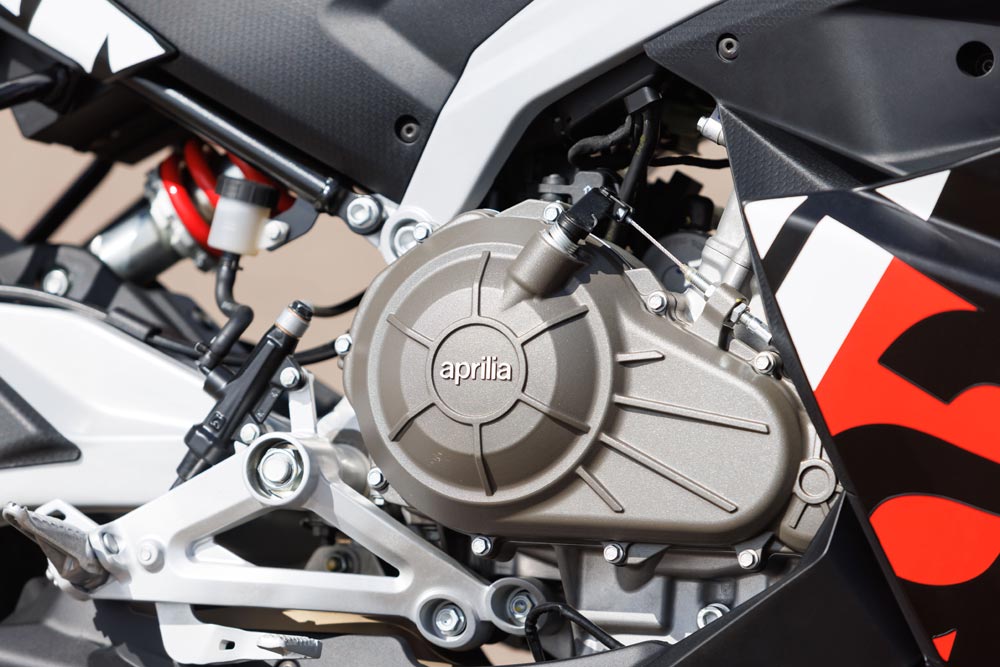 There are 47 Italian horses lurking in there, which isn’t class-leading but not far off.
There are 47 Italian horses lurking in there, which isn’t class-leading but not far off.
Initial throttle response is playful, not scary, and once the engine hums into that 3000 rpm range the real fun begins and the RS is pouncy.
Aprilia chose the Autodromo di Modena as its testing ground since it played to the strengths of a small, lightweight sportbike. Yet something was just slightly off in finding harmony between the peppy twin-cylinder engine and the optimal gearing for the tight and technical circuit. I tried keeping revs high in second gear into corners, but the RS complained loudly as it danced around the redline. Carrying one gear up in third, the RS 457 was sleepy exiting the corners. A consensus was discussed among my fellow riders that some minor tweaks in the final drive gearing ratio would probably remedy this.
The RS 457 comes with three different riding modes, three levels of traction control, and two levels of ABS that can all be independently tweaked to a rider’s content. The rain mode is painfully anemic on the racetrack, but I ran a full lap in it to confirm it functioned as promised (with the TC toggled into its most intrusive setting).
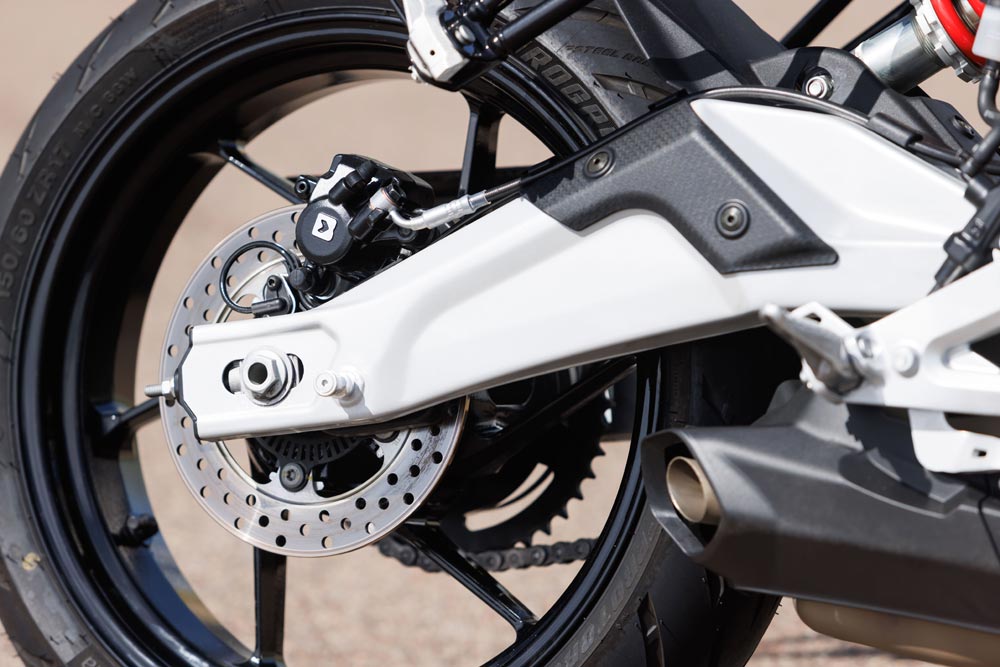 The machine work on the swingarm is top-notch.
The machine work on the swingarm is top-notch.
Throttle response was tepid and peak power was also reined in. The Eco mode surprised me in how closely it related to the Sport mode. It is just a touch softer on the throttle response but delivers peak power very similar to Sport. Sport mode is, of course, the most enjoyable riding mode, unlocking all of the RS 457’s potential. For serious track riders, you can disable ABS to the rear brake, but the front ABS cannot be turned off completely. All these mode adjustments can be made on the fly while riding the bike, which is a nice perk compared to other systems that require a full stop to make changes.
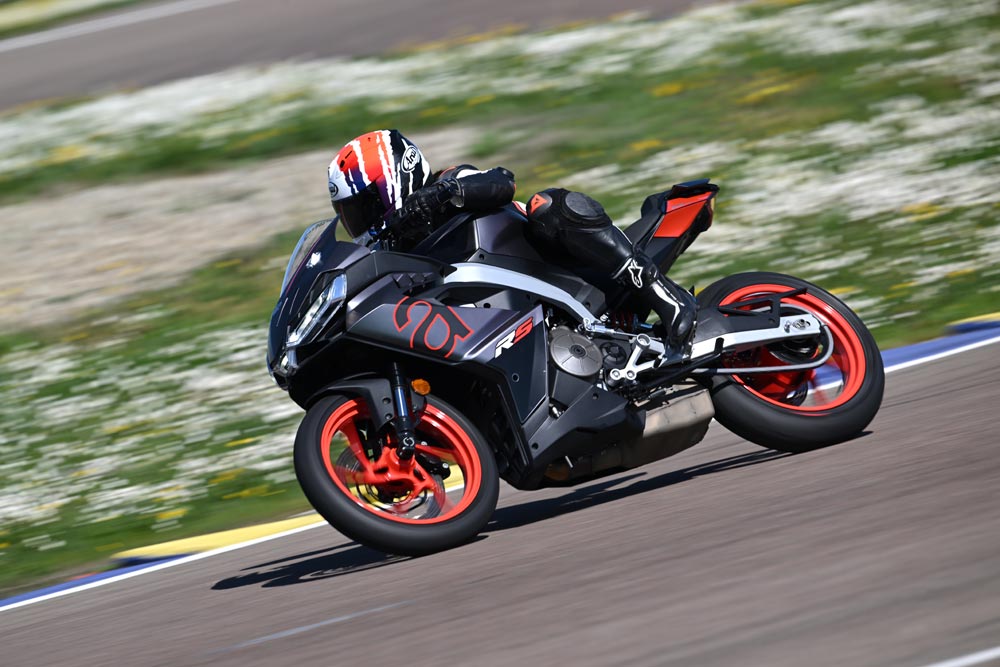 Even more experienced riders will find something to like about the 457 in the corners. It’s a fantastic bit of kit to sharpen your skills on.
Even more experienced riders will find something to like about the 457 in the corners. It’s a fantastic bit of kit to sharpen your skills on.
Chassis | 2024 Aprilia RS 457 Review
Aprilia is unapologetic when describing their ambitions in designing the RS 457 chassis. No concessions were made when infusing the racing spirit and cornering prowess into the youngest and tiniest member of the RS clan.
It was refreshing to hear Piero Soatti, head of motorcycle engineering, say with zero shame, “The suspension is stiff.” OE’s can fall into the trap of trying to please everyone with suspension settings and often end up with an under-sprung mushy mess. For the purposes of riding aggressively on a racetrack, the RS 457 is at the right starting point.
The entry-level RS is outfitted with a 41mm fork (preload adjustable) and a monoshock at the rear (also with adjustable preload). For stopping power, an ABS-equipped ByBre four-piston caliper and 320mm floating disc up front with metal braided brake hose and a single piston caliper with a 220mm at the rear. There aren’t any flashy brand-name components here but for the price point and application, they meet expectations.
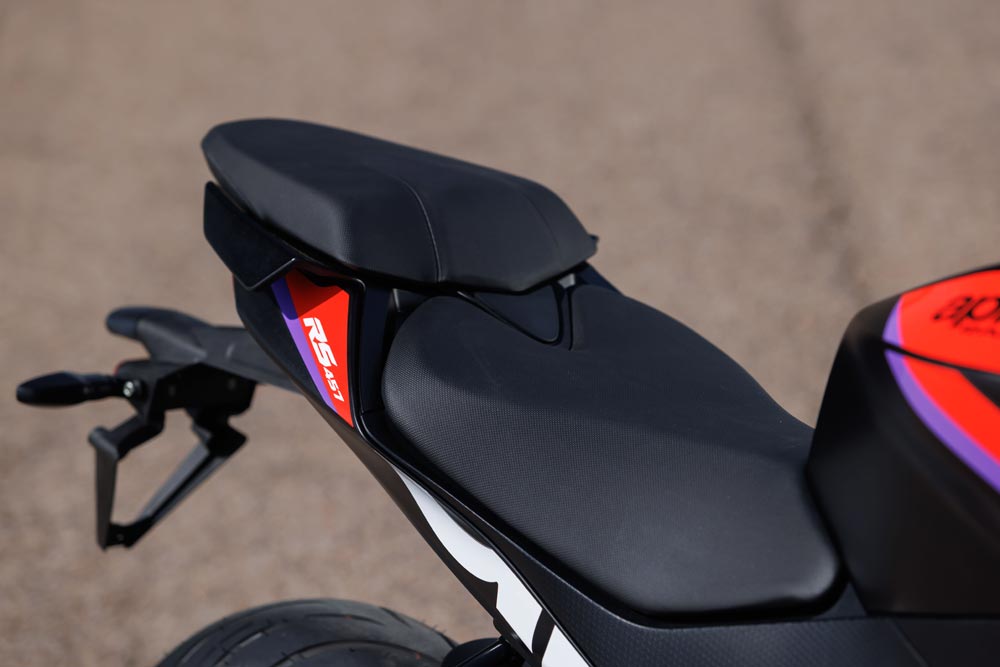 The seat is fine for track days, but it’ll probably get a bit uncomfortable during longer rides.
The seat is fine for track days, but it’ll probably get a bit uncomfortable during longer rides.
The frame is a twin-spar aluminum layout as per most sportbikes out there. In the pursuit of shaving pounds, the engine is used as a stressed member of the chassis and the steel swingarm pivot is mounted directly to the engine.
It’s an elegant ensemble to look at and it produces a sporty sensation in motion.
The fast-switching esses at Modena require serious agility, and the baby RS has been honed to this craft. With the lightest inputs, it would switch direction, and because it’s so narrow and light, the quick transitions felt effortless. On the side of the tires in the longer sweepers, the RS also maintained its composure, and mid-corner corrections (of which there were a few) were drama-free.
The only component that disrupts the spell of the RS 457 chassis is the front brake. It has a curiously long pull before it begins to engage, which did cause some panic grabs in the first few laps. Once my right hand recalibrated itself to the slack of the lever, the brake was predictably smooth and modulated well with incremental pressure. In relation to the sharpness and preciseness of the rest of the chassis, however, the front brake felt amiss.
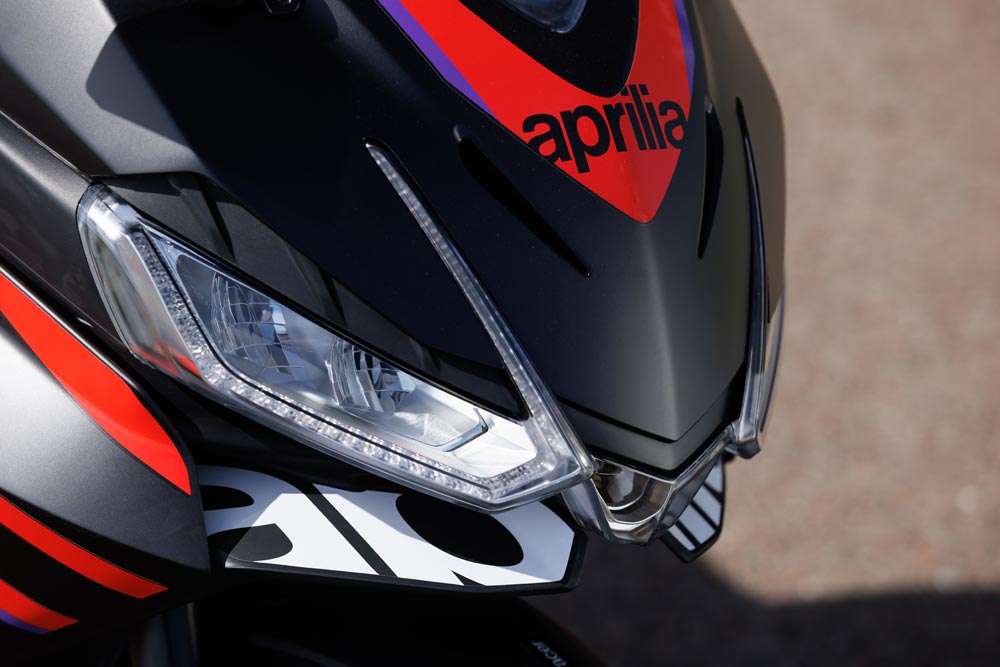 Now, that’s a pretty face for a bike aimed at teenagers.
Now, that’s a pretty face for a bike aimed at teenagers.
Everything Else | 2024 Aprilia RS 457 Review
As far as ergonomics go, Aprilia set out to find a middle ground between what they felt was the too-relaxed neutral position of the Ninja series and the hyper-aggressive rider triangle of the KTM RC 390. Their experimenting resulted in a sporty riding position I found comfortable for my small frame of five foot, four inches.
The seat height on the RS 457 is 31.5 inches, putting me on my toes in the saddle but it’s otherwise manageable. The tallest rider in the group complained that he felt cramped in the cockpit but did compliment Aprilia for their smart gas tank design that had strategic indents for his helmet chin bar to rest in when tucking on the front straight.
The RS 457 is a straight-up stunner in the looks department. The headlights and bodywork are derived from the undisputed beauty of the RS heritage. Components like the frame and swingarm have been carefully designed and exquisitely shaped by Aprilia’s tastemakers. In this category of bike, where price-consciousness often outweighs styling, it is a masterpiece.
Therein lies the rub, however. Since Aprilia insists on being the most premium option in the lightweight sport bike segment, this means that it is the most expensive with an MSRP of $6899.
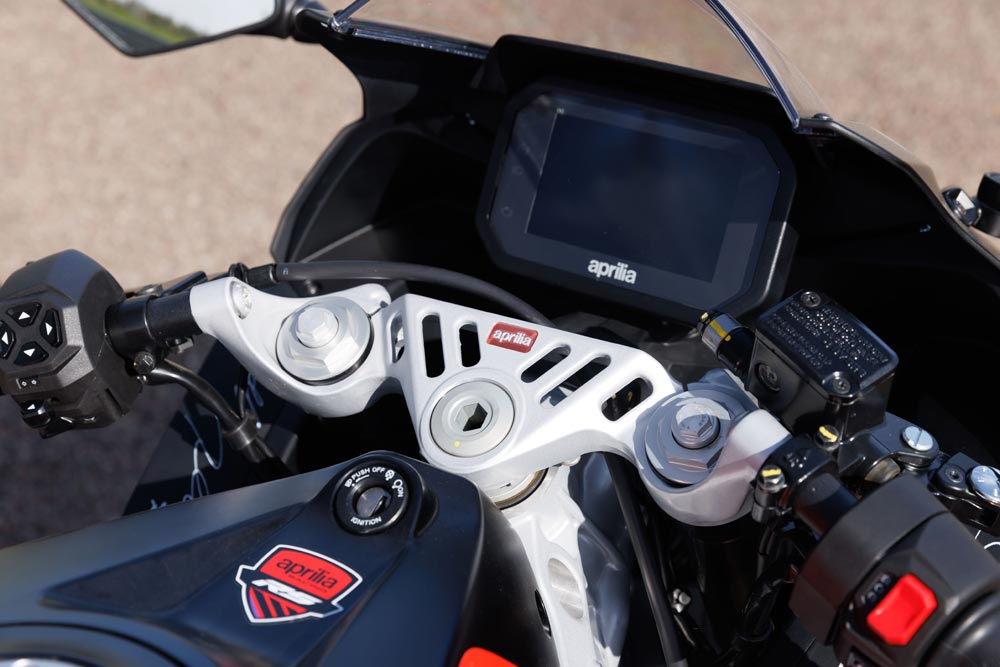 If you didn’t know what you were looking at, you could swear the 457’s cockpit was actually the RS 660’s.
If you didn’t know what you were looking at, you could swear the 457’s cockpit was actually the RS 660’s.
Whether or not it brings enough performance to the table to justify the price tag is open for debate. The Kawasaki Ninja 500 KRT SE ABS edition has a higher horsepower figure—a claimed 51 hp compared to the RS’s 47 horsepower—and comes with a lot of similar technical features for $500 less (or the base model for $1000 less). The KTM RC 390 may not be as powerful as the other two but does come standard with quickshifter, ride modes, ABS, TC and a TFT dash for $1000 less than the RS.
The entry-level motorcycle market has matured, and Aprilia’s timing is late but strategic as it focuses on the upper crust of riders. The RS 457 fills a niche in the model lineup for multiple global markets—an entry-level offering in the U.S., an A2 tiered license option for Europe, and a big bike option in Asia.
Most importantly, it is a breath of fresh air in a segment that has grown stale over the years with the same old offering. Small Ninjas and RCs are ubiquitous on American streets, but an Italian lightweight sport bike that looks like its racey older brother in the RSV4? That is motivation indeed to put up the few extra dollars to stand out at the next bike night or trackday.CN
VIDEO | 2024 Aprilia RS 457 First Ride
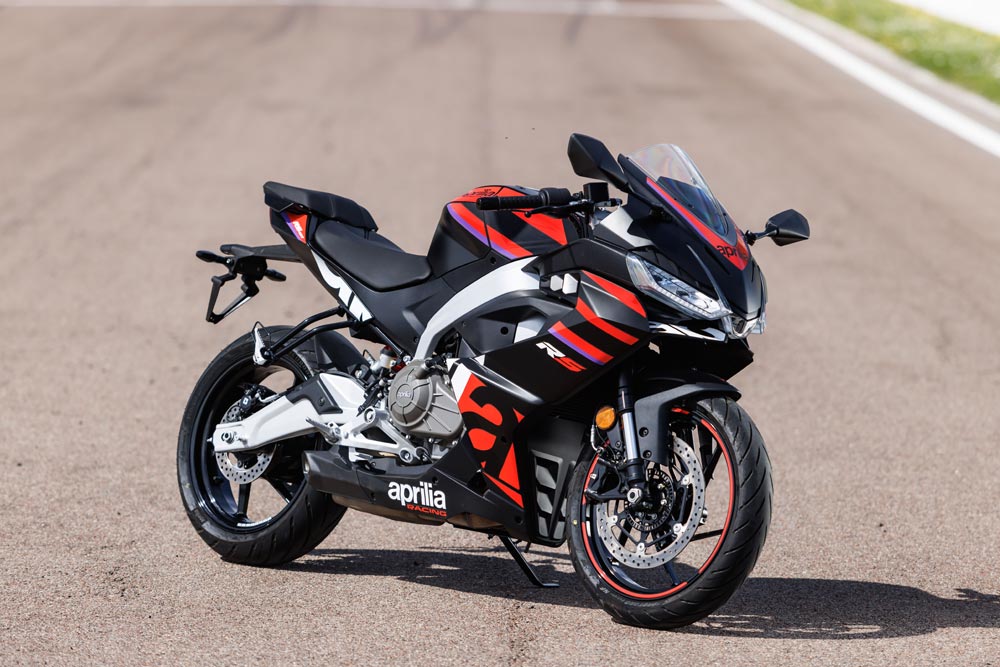
2024 Aprilia RS 457 Specifications
| MSRP: |
$6899 |
| Engine: |
Parallel-twin, 4-stroke |
| Valvetrain: |
4-valve, DOHC |
| Displacement: |
457cc |
| Bore x stroke: |
69 x 61.1mm |
| Cooling system: |
Liquid |
| Max power: |
47 hp at 9400 rpm |
| Max torque: |
32 ft-lb at 6700 rpm |
| Fuel injection: |
Electronic fuel injection system, twin 36mm throttle bodies |
| Exhaust: |
2-1 |
| Transmission: |
6-speed |
| Clutch: |
Wet, multi-plate, slip and assist |
| Electronics: |
Three Riding Modes, ABS, Traction Control |
| Chassis: |
Cast aluminum twin-spar |
| Front suspension: |
41mm inverted fork, adjustable spring preload |
| Rear suspension: |
Monoshock, adjustable spring preload |
| Front-wheel travel: |
4.72 in. |
| Rear-wheel travel: |
5.12 in. |
| Front brake: |
Single 320mm disc, ByBre 4-piston radial monobloc calipers |
| Rear brake: |
Single 220mm disc, ByBre single-piston caliper |
| Front tire: |
110/70 ZR 17 in. |
| Rear tire: |
150/60 ZR 17 in. |
| Rake: |
24.1° |
| Trail: |
4.04 in. |
| Wheelbase: |
53.1 in. |
| Seat height: |
31.5 in. |
| Fuel capacity: |
3.4 gal. |
| Weight (curb): |
385 lbs. |
